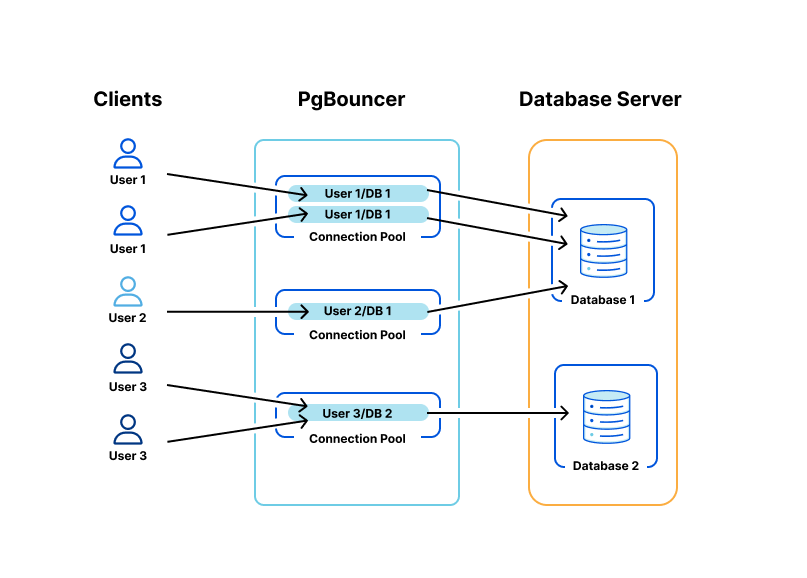
Cloudflare operates highly available Postgres production clusters across multiple data centers, supporting the transactional workloads of our core service offerings such as our DNS Resolver, Firewall, and DDoS Protection.
Multiple PgBouncer instances sit at the front of the gateway layer per each cluster, acting as a TCP proxy that provides Postgres connection pooling. PgBouncer’s pooling enables upstream applications to connect to Postgres, without having to constantly open and close connections (expensive) at the database level, while also reducing the number of Postgres connections used. Each tenant acquires client-side connections from PgBouncer instead of Postgres directly.

PgBouncer will hold a pool of maximum server-side connections to Postgres, allocating those across multiple tenants to prevent Postgres connection starvation. From here, PgBouncer will forward backend queries to HAProxy, which load balances across Postgres primary and read replicas.
As an intern at Cloudflare I got to work on improving how our database clusters behave under load and open source the resulting code.
We run our Postgres infrastructure in non-containerized, bare metal environments which consequently leads to multitenant resource contention between Postgres users. To enforce stricter tenant performance isolation at the database level (CPU time utilized, memory consumption, disk IO operations), we’d like to configure and enforce connection limits per user and connection pool at PgBouncer.
To do that we had to add features and fix bugs in PgBouncer. Rather than continue to maintain a private fork we are open sourcing our code for others to use.
Authentication Rejection
The PgBouncer connection pooler offers options to enforce server connection pool size limits (effective concurrency) per user via static configuration. However, an authentication bug upstream prevented these features from correctly working when Postgres was set to use HBA authentication. Administrators who sensibly use server-side authentication could not take advantage of these user-level features.
This ongoing issue has also been experienced by others in the open-source community:
https://github.com/pgbouncer/pgbouncer/issues/484
https://github.com/pgbouncer/pgbouncer/issues/596
Root Cause
PgBouncer needs a Postgres user’s password when proxying submitted queries from client connection to a Postgres server connection. PgBouncer will fetch a user’s Postgres password defined in userlist.txt (auth_file) when a user first logs in to compare against the provided password. However, if the user is not defined in userlist.txt, Pgbouncer will fetch their password from the Postgres pg_shadow system view for comparison. This password will be used when PgBouncer subsequently forwards queries from this user to Postgres. The same applies when Postgres is configured to use HBA authentication.
Following serious debugging efforts and time spent in GDB, we found that multiple user objects are typically created for a single real user: via configuration loading from the [users] section and upon the user’s first login. In PgBouncer, any users requiring a shadow auth query would be stored under their respective database struct instance, whereas any user with a password defined in userlist.txt would be stored globally. Because the non-authenticated user already existed in memory after being parsed from the [users] section, PgBouncer assumed that the user was defined in userlist.txt, where the shadow authentication query could be skipped. It would not bother to fetch and set the user’s password upon first login, resulting in an empty user password. This is why subsequent queries submitted by the user would be rejected with authentication failure at Postgres.
To solve this, we simplified the code to globally store all users in one place rather than store different types of users (requiring different methods of authentication) in a disaggregated fashion per database or globally. Also, rather than assuming a user is authenticated if they merely exist, we keep track of whether the user requires authentication via auth query or from fetching their password from userlist.txt. This depends on how they were created.
We saw the value in troubleshooting and fixing these issues; it would unlock an entire class of features in PgBouncer for our use cases, while benefiting many in the open-source community.
New Features
We’ve also done work to implement and support additional features in PgBouncer to enforce stricter tenant performance isolation.
Previously, PgBouncer would only prevent tenants from exceeding preconfigured limits, not particularly helpful when it’s too late and a user is misbehaving or already has too many connections. PgBouncer now supports enforcing or shrinking per user connection pool limits at runtime, where it is most critically needed to throttle tenants who are issuing a burst of expensive queries, or are hogging connections from other tenants. We’ve also implemented new administrative commands to throttle the maximum connections per user or per pool at runtime.
PgBouncer also now supports statically configuring and dynamically enforcing connection limits per connection pool. This feature is extremely important in order to granularly throttle a tenant’s misbehaving connection pool without throttling and reducing availability on its other non-misbehaving pools.
PgBouncer Configuration
[users]
dns_service_user = max_user_connections=60
firewall_service_user = max_user_connections=80
[pools]
user1.database1 = pool_size=90PgBouncer Runtime Commands
SET USER dns_service_user = ‘max_user_connections=40’;
SET POOL dns_service_user.dns_db = ‘pool_size=30’;These new features required major refactoring around how PgBouncer stores users, databases weakly referenced and stored passwords of different users, and how we enforce killing server side connections while still in use.
Conclusion
We are committed to improving PgBouncer in open source and contributing all of our features to benefit the wider community. If you are interested, please consider contributing to our open source PgBouncer fork. After all, it is the community that makes PgBouncer possible!

